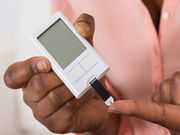Similar efficacy when meals contain 40 to 55 percent total energy from carbohydrate
THURSDAY, Dec. 29, 2016 (HealthDay News) — For patients with type 2 diabetes (T2D), the SGLT2 inhibitor luseogliflozin has similar efficacy when meals contain 40 to 55 percent total energy from carbohydrate (TEC), according to a study published online Dec. 19 in Diabetes, Obesity and Metabolism.
Daisuke Yabe, M.D., Ph.D., from the Kansai Electric Power Research Institute in Kobe, Japan, and colleagues examined the safety and efficacy of luseogliflozin under differing carbohydrate intake in Japanese individuals with T2D. Participants were randomized to carbohydrate-adjusted meals for 14 days: high carbohydrate (HC; 55 percent TEC)-high glycemic index (HGI), HC-low glycemic index (LGI), and low carbohydrate (LC; 40 percent TEC)-HGI. Participants had received luseogliflozin for the past seven days and underwent continuous glucose monitoring (CGM) before and after luseogliflozin treatment.
The researchers found that in all three groups, luseogliflozin significantly decreased the area under the curve and mean CGM values to a similar extent. At all time points, fasting plasma glucose, insulin, and glucagon were similar. On day 15, ketone bodies were significantly increased in LC-HGI versus HC-HGI and HC-LGI.
“In conclusion, luseogliflozin has similar efficacy and safety in Japanese T2D individuals when meals contain 40 to 55 percent TEC, but a strict low-carbohydrate diet on this class of drug should be avoided to prevent SGLT2 inhibitor-associated diabetic ketoacidosis,” the authors write.
Several authors disclosed financial ties to pharmaceutical companies, including Taisho Toyama, which manufactures luseogliflozin and funded the trial.
Full Text (subscription or payment may be required)
Copyright © 2016 HealthDay. All rights reserved.








